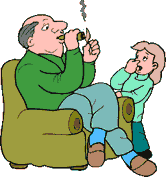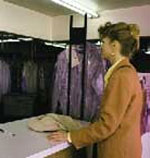|
It's obvious enough that when Uncle Stogie lights up a Cuban bomber your indoor air quality is going to go up in smoke.
 But what about less obvious indoor air quality problems that might degrade the purity of the air your breathing? If your home is like most, your indoor air quality is worse than that of the air surrounding your home—up to five times worse.
But what about less obvious indoor air quality problems that might degrade the purity of the air your breathing? If your home is like most, your indoor air quality is worse than that of the air surrounding your home—up to five times worse.
In the last few decades, better construction techniques have improved the energy efficiency of our houses by making them "tighter"—that is, reducing air seepage around windows, doors, and elsewhere to make it easier for your heating and cooling system to maintain a comfortable temperature. While this is good from an energy standpoint, it's not so good from an indoor air quality standpoint—there is less flow of fresh air from the outside to dilute the chemicals and other pollutants that come from a wide variety of sources inside.
So, is our quest for energy efficiency really to blame for bad indoor air quality? Nope. That's like being in a car and blaming the rolled-up windows for the fact that someone just passed gas.
There are many facets of our modern world that contribute to lousy air inside the home. In this article, we'll go over both indoor air quality problems and solutions, with a focus on sources of chemical pollutants in our indoor air. We'll also suggest ways that you can improve your indoor air quality without keeping the windows open all year long and forking over more money to the utility company.
|
We all understand intuitively that outdoor air gets polluted by the smokestacks of coal plants, by the tailpipes of our cars and trucks, and by other forms of pollution from industry. While it is true that outdoor air pollution can add to indoor air quality problems, we tend to think of the insides of our homes as sealed off from the outside—a semi-hygienic fortress against dirt and pollutants.
|
|
THE INDOOR AIR QUALITY AT JOE CAMEL’S HOUSE |
|
We think it goes without saying, but we're going to say it anyway. If you smoke,
 there is no action you can take on indoor air quality that will improve your health as much as quitting smoking. If you don't smoke but live with someone who does—and they smoke inside—help them quit or ask them to smoke outside.
there is no action you can take on indoor air quality that will improve your health as much as quitting smoking. If you don't smoke but live with someone who does—and they smoke inside—help them quit or ask them to smoke outside.
|
|
Unfortunately, your house's envelope—the walls, windows, doors, and roof—likely keeps in more pollutants than it keeps out. The composition of many of the things we have in our homes—cabinets and other furniture; carpeting and vinyl floors; computers, TVs, and other items with plastic casings; not to mention the chemicals contained in modern construction materials—lead to off-gassing, a process by which vapors exit the solid objects and become pollutants in the surrounding air. We add to the problem by using chemical-laden household products and high-fragrance personal care products.
The health effects of bad indoor air quality will depend on the level and type of exposure, as well as the age and health status of the individual and their tendency toward allergies, but here are some general symptoms:
- irritation of eyes, nose, or throat;
- headaches;
- dizziness, lethargy, "spaciness" or fatigue;
- asthma or other respiratory symptoms; and
- in the case of radon and in cases of serious mold or chemical contamination, cancer and other serious diseases.
The EPA's
The Inside Story: A Guide to Indoor Air Quality
can help you correlate specific symptoms with typical indoor air pollutants.
Long gone are the days when houses were built from rough-hewn logs, limestone, and other all-natural materials. Today's new-home construction materials feature a plethora of chemicals:
- resins to hold together the sheathing in your walls, floors, steps, and roofs;
- formaldehyde, resins, glues, and finishes in your kitchen cabinets and bathroom vanities, as well as paneling and built-in bookcases;
- glues, paints, stains, caulks, and sealants for just about every room in the house.
The chemicals from these materials can cause serious health effects. There are many stories of new homeowners who, after a few weeks or months in their new abode, developed mysterious health symptoms.
If you're considering buying a new home, find out from the builder what steps they take to minimize the impact of new-construction materials on indoor air quality. Warning: Most builders will scoff at any assertion that there will be a problem. You'll do much better working with a green builder. Learn more at the
US Green Building Council.
|
Home remodeling suffers from the same potential problems with chemically construction materials, albeit on a smaller scale. When remodeling your home, though, you have a much greater ability to choose natural and eco-friendly materials. Learn more at the
Green Home Guide.
|
|
HOBBIES AND INDOOR QIR QUALITY |
|
Hobbies like woodworking and crafts can expose one to many of the same chemicals used in construction activities. Do your best to find less toxic alternative materials and supplies, and always try to work in a well ventilated area.
|
|
If you find yourself stuck with traditional, high-chemical construction, you're only solution is increase ventilation until the off-gassing has stopped. That will usually be 3-12 months, but that timeframe can vary greatly.
Like materials used for construction, the materials used for wall-to-wall carpeting, vinyl flooring, and some flooring finishes are often chock-full of nasty chemicals.
Carpeting — Carpet emits low amounts of volatile organic compounds (VOCs), as do padding, adhesives, and other products that may be used for installation. The industry offers products with the Green IAQ Label, which ostensibly assures purchasers that their new carpeting will not contribute to indoor air quality problems. Grinning Planet's experience is that installations of carpeting with the Green IAQ Label still emit enough chemicals to be a problem for sensitive individuals. There are companies that make safer carpets than those of the mainstream carpeting industry, including
Earth Weave
or Natural Home Source.
When cleaning carpeting, avoid chemical-based cleaners or those with strong fragrances. Finally, all carpet is a sink for dust mites, molds, pollen, and other things that can cause indoor air quality problems and health effects. Throw rugs can always be washed, but it's best to avoid wall-to-wall carpet if you can.
Wood Flooring and Laminate Flooring — Either product can be a good choice, but the key is to get a sealed surface that will not allow the exposed sides of the product to continue off-gassing.
Vinyl Flooring — Vinyl sheet goods or tiles on contain polyvinyl chloride, plasticizers and other additives like fungicides—none of that
 will be good for your indoor air quality! Ceramic tile is a better choice for areas where your inclination is to put vinyl.
will be good for your indoor air quality! Ceramic tile is a better choice for areas where your inclination is to put vinyl.
Tile — This is a good choice—ceramic and porcelain are among the "cleanest" flooring products when it comes to not off-gassing.
Be sure to use a Portland-cement-based grout, which gives off no chemical vapors and requires almost no maintenance. Grout can, however, give off a slightly musty smell (because earthy components are a large proportion of its composition). Grout sealer can solve that problem but will reduce indoor air quality until its off-gassing period is over.
Materials used to make furniture, draperies, cubicle dividers, and other furnishings usually have some level of chemical off-gassing. Today's "wood" furniture often has wood veneer or cloth on the outside and particleboard on the inside. Both the cloth and the particleboard usually contain formaldehyde, which can cause a wide variety of health problems. Other VOC emissions can come glues and from fabric and wood finishing agents. Flame retardants found in foam cushions have recently garnered attention as ubiquitous and troublesome
endocrine disruptors.
Look for green alternatives. Some products now carry the
GreenGuard
label, which certifies the use of low-emitting indoor materials, furnishings, and processes. Buying used furniture (at an estate sale or elsewhere) is a great way to get low-cost, excellent furniture that has already done its off-gassing.
Most of the big-name cleaners you find on the shelves at the supermarket contain ammonia, chlorine, ethylene-based glycol, terpenes, or any number of other toxic chemicals with long, unrecognizable names that only an organic chemist could love. The chemicals serve as cleaning agents, solvents, dispersal agents, carriers, dyes, fragrances, and preservatives. Although direct contact with your skin is a primary method of exposure to household cleaning chemicals, breathing their fumes is also a problem. Anyone who has used chlorine bleach to take on a stubbornly dirty shower floor knows this all too well.
Grinning Planet recognizes that these products are effective. However, while they may be a "normal" choice for helping you with your housework, they're not a good choice for helping you with your health. Fortunately, there are easy-to-find, effective alternatives.
Gone are the days when the only alternative to standard cleaners was to mix up your own batches of lemon juice, vinegar, and baking soda. Such concoctions certainly work and can save you a lot of money, but if you prefer the convenience of buying something in a spray bottle, there are many safer alternatives are available from brands like Seventh Generation, Earth Friendly, Dr. Bronner, and Planet.
You can support Grinning Planet's efforts by shopping for green cleaners on Amazon.com. If nothing else, avoid cleaning products with added fragrance.
Most mainstream shampoos, conditioners, lotions, perfumes, soaps, and other personal care products have their own special blend of chemicals, and that is not usually a good thing. The primary method of exposure is going to be direct contact with your skin, but the fumes from some of these products can also be a problem, especially those that are heavy on fragrances.
Flowers, herbs, and most natural things have fragrances. It's not that fragrance is a bad thing, but when the fragrance comes from synthetic chemicals, it's good to be cautious. Additionally, the sum of all the fragrances we are now exposed to in our modern lives amounts to system overload. Over time, such exposure, combined with other factors, can lead to "chemical sensitivity."
Dryer sheets and fabric softeners are one of the worst offenders in this category. They are designed to impregnate your clothes with chemical fragrance that will linger long after the clothes come out of the dryer, thus ensuring you will get a long-term dose of the fragrance chemicals. There are several ways to avoid the expense and hazards of fabric softeners and dryer sheets without resigning oneself to living with wrinkles and static cling—check out our article about
alternatives to fabric softeners.
|
Air fresheners are at the top of the offenders list in the fragrance category. Whether the air freshener is a stick-on, a pop-up, or a plug-in, realize that by using it you are intentionally polluting your indoor air. It's a much better idea to solve the odor problem that causes you to want to use air fresheners in the first place.
|
|
SCENTED CANDLES – PHWEW! |
|
It doesn't really matter what the delivery mechanism is—a spray, a plug-in air freshener, or an aromatic candle—pumping chemical fragrances into your indoor air is a bad idea.
|
|
As with cleaning products, there are many natural, chemical-free personal care products that won't pollute you or your indoor air. (Related article:
Safe Skin Care.)
Many dry cleaning services use a chemical called perchloroethylene (perc) as the primary cleaning solvent. When you bring your clothes home,
 they are still off-gassing perc, whether they're in your closet or you're wearing them. Exposure to perc can cause adverse health effects on the nervous system that include dizziness, fatigue, headaches, sweating, incoordination, and unconsciousness. Long-term exposure can cause liver and kidney damage. The International Association for Research on Cancer classifies perc as a probable carcinogen.
they are still off-gassing perc, whether they're in your closet or you're wearing them. Exposure to perc can cause adverse health effects on the nervous system that include dizziness, fatigue, headaches, sweating, incoordination, and unconsciousness. Long-term exposure can cause liver and kidney damage. The International Association for Research on Cancer classifies perc as a probable carcinogen.
The good news is that many dry cleaning services are now using alternative cleaning solvents that avoid perc. See our article about dry cleaning alternatives.
Wool and other dress clothes often go into a clothes storage bag for the summer, along with a few moth balls. This seemingly smart practice is actually not so smart at all. Most commercial moth repellents contain naphthalene or related compounds. Naphthalene causes anemia and is thought to be a human carcinogen. So, while the vapors from the moth balls may create a toxic environment for the moths, they also are making your environment toxic. A better approach is to build a cedar closet or to use natural alternatives such as cotton balls soaked in lavender oil or dried mint leaves.
No one wants bugs in their house, which is why pesticide companies thrive today despite the fact that most of them make a living by putting neurotoxins in and around your home. Do not infer from the fact that pesticides are government-approved that they are safe for you to use in your house (whether applied by you or a professional). Pesticide testing is simply inadequate to guarantee that use of chemical pesticides is compatible with good health.
The biggest exposure threat to sprayed pesticides—especially if you are doing the spraying—is inhalation. Skin exposure is also an absorption route. But even after pesticides have been sprayed, enough pesticide molecules can remain in the air to cause pesticide exposure to people living in the house. Pesticides sprayed on lawns are also tracked into the house. For alternative approaches, see our organic lawn care article.
There are effective non-toxic methods of combating pests like ants and cockroaches inside your home. You can learn more by reading the
fact sheets
for your pest problems at the provided by the Northwest Coalition for Alternatives to Pesticides web site.
Fumes from your garage can filter into your living space. The fumes can come from a variety of sources in the garage: stored gasoline; oils and other automotive fluids; exhaust fumes from cars.
Here are some suggestions for minimizing the problem:
- Keep all fluid containers tightly sealed.
- Do not idle your car in the garage.
- After pulling your vehicle into the garage, leave the garage door open for a few minutes to let the exhaust fumes clear out.
- Keep the entryway door to the house closed at all times.
|
There are a number of other serious indoor air quality problems that you should be aware of. We list them below and provide resources for further reading.
Radon – See the side bar to the right
Lead – See Grinning Planet's lead exposure article
Asbestos – See EPA's asbestos page
Mold – See EPA's mold resources page
Pet Dander – See the Consumer Product Safety Commission's (CPSC) page titled Biological Pollutants in Your Home
Fireplaces; wood stoves oil heat; gas heat; gas stoves; kerosene heaters; etc. – See CPSC's article The Inside Story—A Guide to Indoor Air Quality
|
|
RADON — AN INDOOR AIR QUALITY KILLER |
|
Radon is a radioactive gas, a decay product of radium that occurs naturally in soil and rock. Other sources of radon can include well water and some building materials, though these are less likely. Radon typically seeps out of the ground and into your house through:
-- cracks and other holes in the foundation;
-- construction joints;
-- cracks or gaps in walls and floors; and
-- gaps around plumbing pipes and wire penetrations.
The radon can get trapped inside your house and build up.
According to the US EPA, indoor radon exposure is the second leading cause of lung cancer in the United States and the leading cause among non-smokers. The EPA estimates that roughly 20,000 people die in the US each year due to indoor radon exposure.
Radon is colorless and odorless, so you can't "sniff it out." There are, however, inexpensive test kits that will allow you to check the radon level in your home—check with your local hardware store. Other options:
-- Get a radon-test checklist and find out about certified radon test labs via the National Environmental Health Association's National Radon Proficiency Program.
-- Call the National Radon Hotline at 1-800-SOS-RADON (1-800-767-7236) or see the EPA's Citizen's Guide to Radon.
-- Find your state EPA radon guru via EPA's state and regional listing.
If you heard somewhere that it's a myth that radon in homes causes cancer, you should read EPA's page about radon health risks. Radon can be a serious indoor air quality problem.
|
|
Finally, don't "cheap out" when purchasing air filters for your HVAC system. Good filters can do a great job of filtering out dust, pollen, and mold particles—as long as you change them regularly. However, even a great filter will not filter out fumes from chemicals, petroleum products, and fragrances. Getting rid of those requires not letting them get into the house in the first place.
|
Do you know someone who is probably suffering because of indoor air quality problems? Please send them this article.
Books:
- See books related to indoor air quality
Get Grinning Planet by email:
Sign up for our free email list so you don't miss anything! Options:
More articles and resources on....
|
| |
GP ARTICLES RELATED TO
Home Air Pollution
|
| |
|
IMPURITEASE IN THE AIR AT THE TASSEL CLUB
Pollution and Health
— Human Effects and Costs
IN THE AIR WING, MAJOR POLLUTANTS OUTRANK GENERAL POLLUTANTS
Criteria Air Pollutants – The Six Major Air Pollutants
HATE MAIL FROM SOME FLOUNDER
Mercury in Fish
— Which Fish, and Why?
OUR HOUSE IS A VERY, VERY, VERY FINE HOUSE ... OF HORRORS
Home Chemical Safety
Is More than Just Keeping Toxics Out of the Reach of Children
|
| |
|
ABOUT AMAZON LINKS:
Shopping at Amazon via the links on this and other pages on Grinning Planet helps support our effort to inform the world about environmental issues and green solutions. Thanks!
Search Amazon.com ....
|


